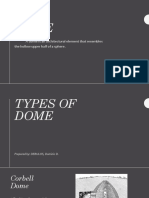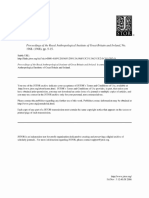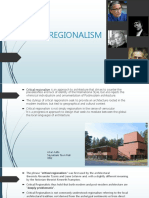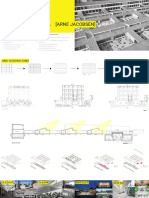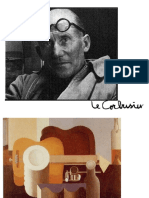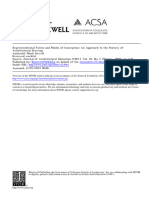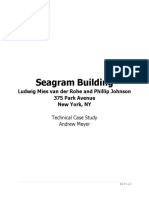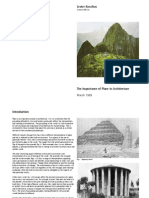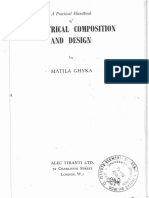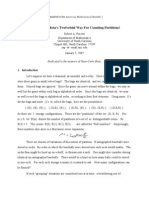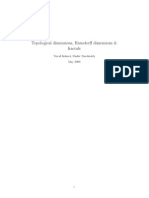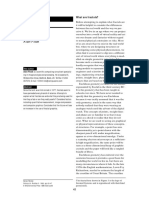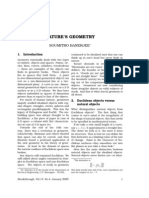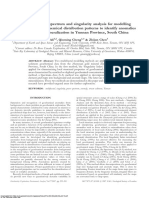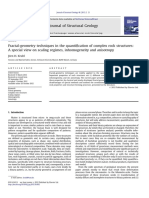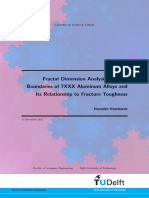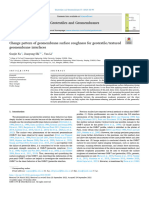Carl Bovill
Uploaded by
kushal786kushal786Carl Bovill
Uploaded by
kushal786kushal786Journal for Geometry and Graphics
Volume 4 (2000), No. 1, 71–78.
Fractal Geometry as Design Aid
Carl Bovill
School of Architecture, University of Maryland
College Park, MD 20742-1411, USA
email: [email protected]
Abstract. From Charles Jencks in England to Itsuko Hasegawa in Japan,
there is discussion in the architectural press of chaos, fractals, complexity theory,
and self-organization. Architecture and design should be informed by and express
the emerging scientific view that the world around us is more chaotic and complex
than previously thought. However, the architectural response has a tendency
to be fairly shallow. Twists and folds and waves, jumps in organizing grids, and
superposition of different ordering systems are used to express in architectural form
the new scientific ideas about complexity. These are moves in the right direction
toward connecting architecture with contemporary cosmic concepts. However,
knowledge of the mathematics of fractal geometry can provide a path to an even
deeper expression.
Key Words: Fractal geometry, architecture.
MSC 1994: 00A06.
1. Introduction
Fractal geometry is the formal study of self-similar structures and is at the conceptual core
of understanding nature’s complexity. The fractal dimension provides a measure of the com-
plexity of a structure. It is a measure of the mixture of order and surprise in a structure. The
measured dimension and the box counting dimension methods provide procedures that can
determine the fractal dimension of natural shapes like coast lines or mountain ridges and man
made shapes like Frank Lloyd Wright’s stained glass windows. Natural rhythms in time are
also fractal. Range analysis provides a method of quantifying the fractal dimension of these
rhythms. Midpoint displacement methods provide procedures for generating fractal rhythms
that can be used to set up complex rhythms in a building design that echo the complexity of
nature. Musical rhythms provide easy access to fractal rhythms if a computer is not available.
Curdling provides a method of generating fractal fields in two and three dimensions. Iter-
ated function systems provide a means of generating an unlimited diversity of fractal shapes.
None of these methods are difficult to use and they provide the designer with the power to
get beyond the superficial to a deeper expression and exploration of the cosmic complexity
that contemporary science is disclosing.
c 2000 Heldermann Verlag
ISSN 1433-8157/$ 2.50 °
72 C. Bovill: Fractal Geometry as Design Aid
2. The Measured Dimension
Mandelbrot [7] presents the measured dimension through a discussion of the length of the
coast of England. A coastline is an irregular form that is made up of large and small bays
and inlets and rocky points as well as relatively even beaches. The measurement problem is
that one has to use a straight measuring device. If the length of the coastline is determined
with a mile long measuring device a length will be determined. This length will not include
many irregular features that are smaller in scale than one mile. Another measurement can be
made with a measuring device that is 100 yards long. This length measurement will include
more of the irregularities than the measurement with the mile long device but it will also
leave out some irregularities. The problem is that the measurement of coastline length keeps
getting longer as the measuring device gets smaller. Mandelbrot [7] suggests that coastline
length is thus very poorly defined. He proposes that if the measured length and the length
of the measuring device are plotted they form a power law relationship. The exponent of the
power law relationship is usually fractional for natural features like coastlines. In the case of
the coastline of Britain the number is approximately 1.25 . Mandelbrot [7] then suggested
the extraordinary concept that this represents a dimension. The coastline is more than a line
with dimension one but less than a surface with dimension two.
3. The Box Counting dimension
Figure 1: A Koch curve developed through four levels.
The measured dimension method can only be used in the case where the irregularities to
be measured are in the form of a continuous line like a coastline. When one would like to
include offshore islands in the calculation or do a calculation of the fractal dimension of an
irregular group of lines, then the box counting procedure is appropriate. In the box counting
method a grid of boxes of a given size (s1 ) is superimposed over the drawing to be measured.
C. Bovill: Fractal Geometry as Design Aid 73
The number of boxes with lines in them is counted (n1 ). Then a smaller grid of boxes (s2 )
is superimposed over the drawing. The number of these smaller boxes with lines from the
drawing in them is counted (n2 ). The fractal dimension at this scale range is then calculated
by subtracting log n1 from log n2 and then dividing this by the difference between log s1 and
log s2 (Peitgen et al. [8]). This calculation represents the slope of a line on a log-log plot of
the points in question. A mathematical fractal like the Koch curve, shown as Fig. 1, that
continues its irregularities to infinity will have the same fractal dimension no matter what
box sizes one uses from very large to very small. Natural forms like coastlines tend to have a
scale range over which they are fractal.
Figure 2: A box counting grid placed over a window from the Robie House.
Bovill [4] has used the box counting method to explore the fractal characteristics of
Frank Lloyd Wright’s work. The long elevation of the Robie House displays a fractal
dimension that slowly drops from 1.6 toward 1.4 as the measurement scale drops from 24
feet to 3 feet. This range of scale represents the progression of views from across the street
to approaching the front door. The fractal dimension of a typical casement window from
the Robie House was determined to range from 1.7 to 1.6 through a scale range of six inches
down to one and a half inches. Wright kept up the complexity of his designs through a scale
range from 24 feet down to one inch. Fig. 2 shows a box counting grid placed over a casement
window from the Robie House. This is not surprising since his writings about design keep
coming back to observation of the deep structure of nature. Nature as Mandelbrot [7] has
shown is fractal. Nature displays a cascade of complexity from the organization of galaxies in
the universe (Mandelbrot [7]) to the structure of gold clusters observed under an electron
microscope (Feder [6]). The Villa Savoye subjected to a box counting analysis displays a
fractal dimension of 1.4 at the scale range of 8 feet but rapidly descends to a box counting
dimension of 1.0, minimal complexity, at the scale range of one foot (Bovill [4]). Corbu’s
forms display complexity at large and mid scale ranges but flatten out at the close in scale
range of a few feet down to inches.
74 C. Bovill: Fractal Geometry as Design Aid
4. Range Analysis
The box counting dimension looks at the cascade of complexity of line from large scale to
small scale. It will not however see with much precision the difference between a very regular
cascade of line density, and a cascade of line density that has a complex rhythm structure.
To determine the fractal characteristics of rhythm structures one must use range analysis.
Range analysis comes from H. E. Hurst who studied natural fluctuations through time
(Feder [6]). One of the time rhythms Hurst studied was flood levels on rivers. If one plots
flood levels over time the range from the lowest to the highest level can be measured. Range
analysis is performed by dividing the time span into equal sized increments (t1 ). The average
range from high to low value is calculated (r1 ). Then the time span is divided into smaller
increments (t2 ) and the average range from high to low value is calculated (r2 ). In general
as the time increments get smaller the range gets smaller. The Hurst Exponent is then
calculated as
log r1 − log r2
log t1 − log t2
(Bovill [4]). The fractal dimension is equal to two minus the Hurst Exponent.
A central characteristic of vernacular building is the pleasant variation in visual com-
position that is achieved with a limited pallet of architectural components. Range analysis
was applied to this vernacular variation by Bovill [5]. The process was looking for an or-
dering of the architectural elements that provided the most consistent fractal measurements
across a range of scales. The result showed that there was more than one ordering of the
architectural elements that produced a consistent fractal calculation across a range of scales
and that different orderings produced different fractal measurements. This suggests that the
attraction to the complex rhythms of vernacular design may result from the ability to order
the composition in multiple overlapping ways. Classical compositions generally provide only
one ordering of the composition to the observer.
5. Midpoint Displacement
Midpoint displacement is the most common method of producing fractal rhythms in time.
By varying the scaling of the midpoint jogs of a curve in an iterative procedure, rhythms
with different fractal dimensions can be produced. Adding a random component to the jogs
produces random fractal rhythms that are similar to the random fractal rhythms that Hurst
observed in natural fluctuations in time like river flows and temperature variations. Midpoint
displacement can be produced by hand at a small scale (Bovill [4]), but to truly explore
midpoint displacement a computer is necessary.
6. Music as a Source of Fractal Rhythms
If a computer program is not available to produce fractal rhythms, musical scores can be used.
Richard Voss has studied many forms of music and shown that they all show similar fractal
characteristics (Barnsley et al. [2]). Range analysis can be used to measure the fractal
dimension of a line of sheet music (Bovill [4]).
Musical scores provide a very easy to use method of varying the heights and or widths
of a grouping of elements in an architectural composition like a row of townhouses. All that
needs to be done is to assign an appropriate range of height or width to the musical scale.
C. Bovill: Fractal Geometry as Design Aid 75
Figure 3: A row of townhouses laid out with the aid of a line of sheet music.
Then the notes on the score pick out a fractal variation of height and or width as shown in
Fig. 3. In a similar way architectural elements like window types, or cornice moldings can be
chosen in a fractal manner by ordering the architectural elements to be chosen to the musical
scale and then letting the notes chose the element (Bovill [4]).
7. Curdling
Mandelbrot [7] gave the name curdling to a procedure that produces a random fractal dust
in two dimensions. A fractal dust is a disconnected set of points that displays a clustered
characteristic. The Cantor set is an example of a fractal dust, however the Cantor set is
regular in its clustering. The stars in the night sky are a good example of a random fractal
dust.
Figure 4: An example of curdling to create a complex layout in plan.
Curdling is very simple. Start with a grid on a piece of paper. Then use a coin, dice,
or random generator to decide whether each of the squares of the grid is kept or not. Then
subdivide the kept squares again with a grid and repeat the process. This process is repeated
until the resolution of the drawing is reached. Fig. 4 shows an example of curdling through
76 C. Bovill: Fractal Geometry as Design Aid
three levels. Curdling produces a set of points that have a random clustered structure on to
which the observer can project his own interpretation of order. This makes curdling an ideal
method of exploring graphical interpretations of the concept of deconstruction.
8. Iterated Function Systems
Iterated function systems (IFS) provide a mathematical connection between the classic fractals
like the Koch curve and natural shapes like coastlines (Peitgen et al. [8]). Peitgen,
Jurgens, and Saup describe how IFS work through the analogy of a copy machine with
multiple reducing lenses. The resultant copies are fed back into the machine in an iterative
process. An interesting thing happens. The configuration of the lenses is what determines the
shape of the final image. What the original image was does not matter. For example, if there
are three reducing lenses arranged in an equilateral triangle, it does not matter whether the
original image was squares, circles, or ducks the final image will be the Sierpinski gasket.
Figure 5: An iterated function system configuration in the form of columns
holding up a lintel produces an image of fluted columns.
C. Bovill: Fractal Geometry as Design Aid 77
Figure 6: The four level deep fractal character of a Doric temple — the entire temple,
the fluted columns, the triglyphs, and the mutules created with an IFS.
9. Conclusion, Fractal Geometry as Design Aid
Fractal geometry provides many avenues of exploration for the architect or artist who is
interested in the new complex view of the world that science and mathematics are developing.
However it does take a little effort to conquer some mathematics and a little faith to let the
mathematics enter and influence the art.
78 C. Bovill: Fractal Geometry as Design Aid
Figure 7: An iterated function system configuration used to explore
the creation of organic ornament.
References
[1] E. Ayrton: The Doric Temple. Thames and Hudson, Holland 1961.
[2] M. Barnsley, R. Devaney, B. Mandelbrot, H. Peitgen, D. Saup, R. Voss:
The Science of Fractal Images. Springer-Verlag, New York 1988.
[3] M. Barnsley: The Desktop Fractal design System. Academic Press, Boston 1992.
[4] C. Bovill: Fractal Geometry in Architecture and Design. Birkhauser, Boston 1996.
[5] C. Bovill: Fractal Calculations in Vernacular Design. Proc. International Association
for the Study of Traditional Environments, Berkeley, December 1996. Volume Ninety-
Seven / IASTE 97–96.
[6] J. Feder: Fractals. Plenum Press, New York 1988.
[7] B. Mandelbrot: The Fractal Geometry of Nature. W.H. Freeman and Company, New
York 1983.
[8] H. Peitgen, H. Jurgens, D. Saup: Chaos and Fractals. Springer-Verlag, New York
1992.
Received August 14, 1998; final form December 13, 1999
You might also like
- Kunsthal / Oma - Architecture Analysis: Site PlanNo ratings yetKunsthal / Oma - Architecture Analysis: Site Plan1 page
- Community and Privacy Toward A New Architecture of Humanism PDF0% (3)Community and Privacy Toward A New Architecture of Humanism PDF2 pages
- Sensation of Space and Modern Architecture A Psychology of Architecture by Franz L WitschNo ratings yetSensation of Space and Modern Architecture A Psychology of Architecture by Franz L Witsch23 pages
- Wittkower The Changing Concept of Proportion100% (1)Wittkower The Changing Concept of Proportion18 pages
- Fractal Geometry and Architecture Design PDFNo ratings yetFractal Geometry and Architecture Design PDF12 pages
- 4D-Visualization: Three-Dimensional SpaceNo ratings yet4D-Visualization: Three-Dimensional Space24 pages
- Mathematics in Ancient India: 1. An OverviewNo ratings yetMathematics in Ancient India: 1. An Overview16 pages
- Geometry Concepts in Architectural Design PDFNo ratings yetGeometry Concepts in Architectural Design PDF9 pages
- A Dome Is An Architectural Element That Resembles The Hollow Upper Half of A SphereNo ratings yetA Dome Is An Architectural Element That Resembles The Hollow Upper Half of A Sphere46 pages
- The Minimum Dwelling - Charles DarrousezNo ratings yetThe Minimum Dwelling - Charles Darrousez56 pages
- The Geometry of Art and Life Matila GhykaNo ratings yetThe Geometry of Art and Life Matila Ghyka96 pages
- The Music of Spheres (God As A Geometer)No ratings yetThe Music of Spheres (God As A Geometer)17 pages
- A Scientific Basis For Creating Architectural FormsNo ratings yetA Scientific Basis For Creating Architectural Forms26 pages
- Bauhaus Ideology, Concept and Method On Architecture: January 2008No ratings yetBauhaus Ideology, Concept and Method On Architecture: January 200814 pages
- Microclimatic Impact: Glare Around The Walt Disney Concert HallNo ratings yetMicroclimatic Impact: Glare Around The Walt Disney Concert Hall6 pages
- Timeless Way of Building:: An Examination of The Universal StepsNo ratings yetTimeless Way of Building:: An Examination of The Universal Steps19 pages
- Sacred Geometry: Analyzing Geometry in Indian Temple ArchitectureNo ratings yetSacred Geometry: Analyzing Geometry in Indian Temple Architecture12 pages
- On Some Discoveries of The Methods of Design Employed in Mohammedan Art - Hankin - Final100% (1)On Some Discoveries of The Methods of Design Employed in Mohammedan Art - Hankin - Final34 pages
- Case Study of Buildings of Frank Gehry, B.V DOSHI, Brinda Somaya and Their PhilosophyNo ratings yetCase Study of Buildings of Frank Gehry, B.V DOSHI, Brinda Somaya and Their Philosophy5 pages
- Geometry Concepts in Architectural DesignNo ratings yetGeometry Concepts in Architectural Design10 pages
- Mark Hewitt - An Approach To The History of Architectural DrawingNo ratings yetMark Hewitt - An Approach To The History of Architectural Drawing9 pages
- The Istiqlal Masjid, A Reflection of The Time of SukarnoNo ratings yetThe Istiqlal Masjid, A Reflection of The Time of Sukarno13 pages
- Seagram Building: Ludwig Mies Van Der Rohe and Phillip Johnson 375 Park Avenue New York, NYNo ratings yetSeagram Building: Ludwig Mies Van Der Rohe and Phillip Johnson 375 Park Avenue New York, NY8 pages
- Ronchamp Gatehouse and Monastery: Fondazione Renzo PianoNo ratings yetRonchamp Gatehouse and Monastery: Fondazione Renzo Piano55 pages
- A Practical Handbook of Geometrical Composition and Design Matila Ghyka 1952c 1964 PDFNo ratings yetA Practical Handbook of Geometrical Composition and Design Matila Ghyka 1952c 1964 PDF64 pages
- Let's Expand Rota's Twelvefold Way For Counting Partitions!: Dedicated To The Memory of Gian-Carlo RotaNo ratings yetLet's Expand Rota's Twelvefold Way For Counting Partitions!: Dedicated To The Memory of Gian-Carlo Rota26 pages
- An Analytic Study of Architectural Design Style by Fractal Dimension MethodNo ratings yetAn Analytic Study of Architectural Design Style by Fractal Dimension Method6 pages
- Fractal Models in Architecture: A Case of StudyNo ratings yetFractal Models in Architecture: A Case of Study7 pages
- A Method of Compositional Fractal Analysis and Its Application in Islamic Architectural EnsemblesNo ratings yetA Method of Compositional Fractal Analysis and Its Application in Islamic Architectural Ensembles13 pages
- Fractal-Based Description of Urban FormNo ratings yetFractal-Based Description of Urban Form12 pages
- Fractaldimensionin Architecture An Explorationof Spatialdimension 2017No ratings yetFractaldimensionin Architecture An Explorationof Spatialdimension 2017107 pages
- Fourier Synthesis of Ocean Scenes 87 PDFNo ratings yetFourier Synthesis of Ocean Scenes 87 PDF8 pages
- Download ebooks file The Fractal Geometry of the Brain (2nd Edition) Antonio Di Ieva all chapters100% (1)Download ebooks file The Fractal Geometry of the Brain (2nd Edition) Antonio Di Ieva all chapters65 pages
- Fractality in The Threshold Condition of Fatigue Crack Growth: An Interpretation of The Kitagawa DiagramNo ratings yetFractality in The Threshold Condition of Fatigue Crack Growth: An Interpretation of The Kitagawa Diagram10 pages
- Fractal Time - Why A Watched Kettle Never Boils - Susie Vorbel100% (5)Fractal Time - Why A Watched Kettle Never Boils - Susie Vorbel306 pages
- Journal of Rock Mechanics and Geotechnical Engineering: Kunui Hong, Eunchol Han, Kwangsong KangNo ratings yetJournal of Rock Mechanics and Geotechnical Engineering: Kunui Hong, Eunchol Han, Kwangsong Kang7 pages
- MMW Module 1 - Patterns, Transformation & FractalsNo ratings yetMMW Module 1 - Patterns, Transformation & Fractals17 pages
- Fractal Dimension of Islamic Architecture - The Case of The Mameluke Madrasas - Al-Sultan Hassan Madrasa (#414947) - 660186No ratings yetFractal Dimension of Islamic Architecture - The Case of The Mameluke Madrasas - Al-Sultan Hassan Madrasa (#414947) - 66018611 pages
- Fractal Geometry As The Synthesis of Hin PDFNo ratings yetFractal Geometry As The Synthesis of Hin PDF15 pages
- Benoit Mandelbrot and The Geometry of Chaos PDFNo ratings yetBenoit Mandelbrot and The Geometry of Chaos PDF4 pages
- Fractal Antennas: Ahmed Kiani, 260059400 Syed Takshed Karim, 260063503 Serder Burak Solak, 260141304No ratings yetFractal Antennas: Ahmed Kiani, 260059400 Syed Takshed Karim, 260063503 Serder Burak Solak, 2601413049 pages










